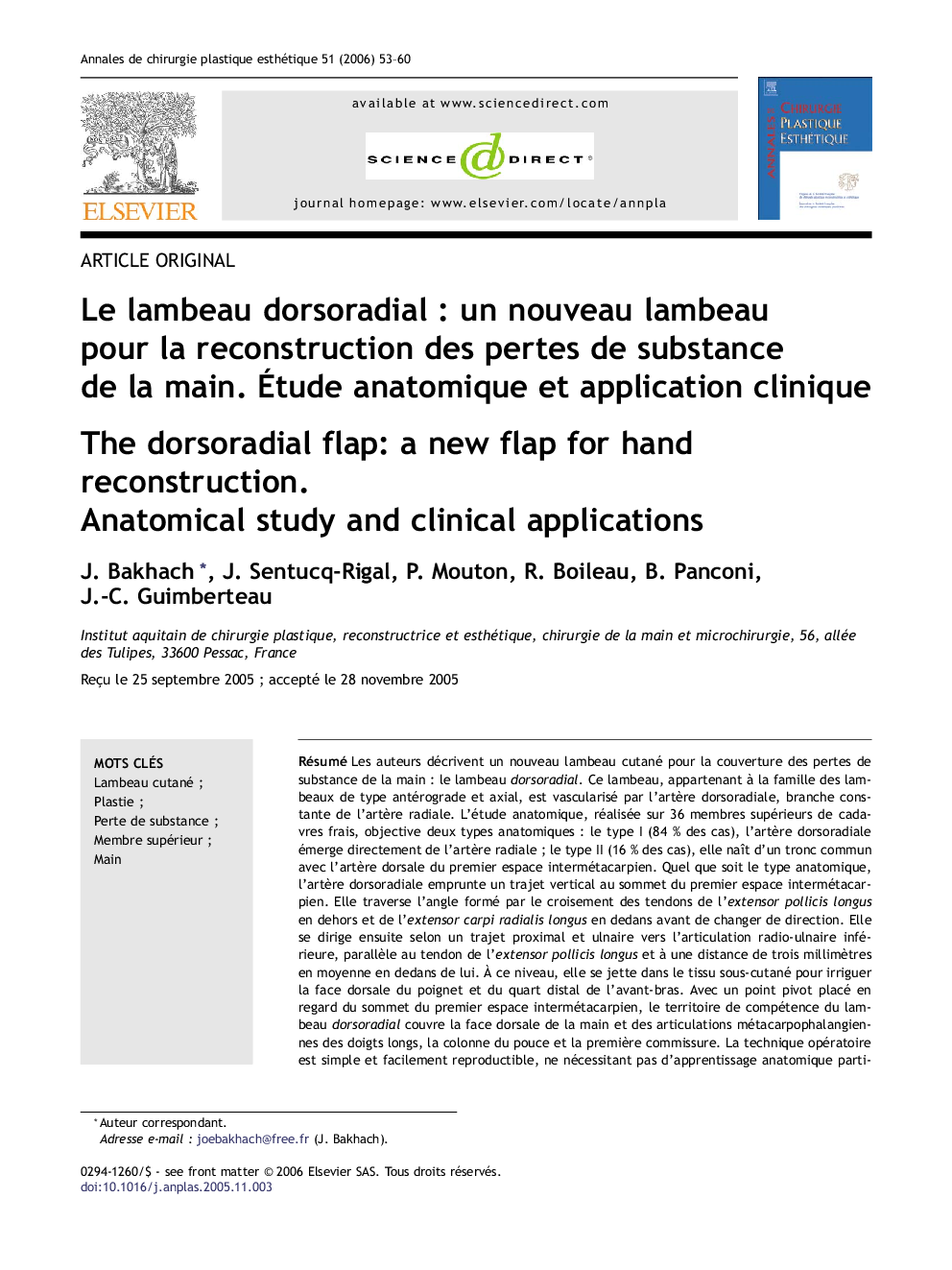| Article ID | Journal | Published Year | Pages | File Type |
|---|---|---|---|---|
| 3185482 | Annales de Chirurgie Plastique Esthétique | 2006 | 8 Pages |
RésuméLes auteurs décrivent un nouveau lambeau cutané pour la couverture des pertes de substance de la main : le lambeau dorsoradial. Ce lambeau, appartenant à la famille des lambeaux de type antérograde et axial, est vascularisé par l'artère dorsoradiale, branche constante de l'artère radiale. L'étude anatomique, réalisée sur 36 membres supérieurs de cadavres frais, objective deux types anatomiques : le type I (84 % des cas), l'artère dorsoradiale émerge directement de l'artère radiale ; le type II (16 % des cas), elle naît d'un tronc commun avec l'artère dorsale du premier espace intermétacarpien. Quel que soit le type anatomique, l'artère dorsoradiale emprunte un trajet vertical au sommet du premier espace intermétacarpien. Elle traverse l'angle formé par le croisement des tendons de l'extensor pollicis longus en dehors et de l'extensor carpi radialis longus en dedans avant de changer de direction. Elle se dirige ensuite selon un trajet proximal et ulnaire vers l'articulation radio-ulnaire inférieure, parallèle au tendon de l'extensor pollicis longus et à une distance de trois millimètres en moyenne en dedans de lui. À ce niveau, elle se jette dans le tissu sous-cutané pour irriguer la face dorsale du poignet et du quart distal de l'avant-bras. Avec un point pivot placé en regard du sommet du premier espace intermétacarpien, le territoire de compétence du lambeau dorsoradial couvre la face dorsale de la main et des articulations métacarpophalangiennes des doigts longs, la colonne du pouce et la première commissure. La technique opératoire est simple et facilement reproductible, ne nécessitant pas d'apprentissage anatomique particulier. La seule précaution opératoire à prendre est de prélever le pédicule nourricier en masse avec toute l'ambiance cellulograisseuse qui l'entoure sur au moins un centimètre de large, ce qui permet d'éviter de générer un spasme artériel et protège les veines comitantes de drainage. Les bases anatomiques et la technique de prélèvement sont détaillées. Elles sont appuyées par des cas cliniques qui permettent de définir les indications chirurgicales de ce nouveau lambeau qui a sa place dans l'arsenal actuel des moyens thérapeutiques de reconstruction des pertes de substance de la main.
The authors report a new cutaneous flap harvested from the dorsal and distal quarter of the forearm: the dorsoradial flap. The vascularisation type of the cutaneous paddle belongs this flap to the anterograde and axial family flaps. The anatomical study carried out on thrirty six fresh cadaver upper arms showed a constant and a consistant cutaneous collateral branch of the radial artery which arises at the apex of the first intermetacarpal space. Two anatomical types were recorded according to the origin of the dorsoradial artery: type I (84% of cases), the vessel arises directly from the radial artery; type II (16% of cases), it arises from a common trunck with the first dorsal intermetacarpal artery. Those anatomical findings does not influence the flap operative technique, the flap design and the location of the pedicle pivot point. The dorsoradial artery emerges vertically from the apex of the first intermetacarpal space, crosses the angle between the extensor pollicis longus tendon lateraly and the extensor carpi radialis longus tendon medialy and turns proximaly towards the distal radio-ulnar joint. Over the dorsal aspect of the wrist, the dorsoradial artery enters the subcutaneous tissue, runs parrallel to the extensor pollicis longus tendon at three millimeters in a medial position, passes over the medial collateral branch of the superficial radial nerve and irrigates all the distal and dorsal quarter of the forearm. The artery is consistently accompanied by two comitantes veins, which assume the venous drainage of the cutaneous territory. The flap paddle is designed over the distal dorsal forearm quarter, between the dorsal crease of the wrist distaly, the ulnar crest medialy and the radial crest lateraly. All this skin territory can be harvested and supplied by the dorsoradial pedicle, but we always should deal with the needs of the defects reconstruction and the morbidity of the donor site. The vascular pedicle is outlined between the distal radio-ulnar joint and the apex of the first intermetacarpal space with a minimum of one centimeter width. The surgical procedure is carried out under a tourniquet without an upper arm exsanguination. The skin is firstly dissected over the vascular pedicle through an S shape incision; it is lifted on the dermo-hypodermis plan preserving all the superficial venous network with the pedicle. The flap is elevated from proximal to distal including the dorsal forearm fascia. Over the dorsal extensor retinaculum, the dissection is underwent close to it elevating all the subcutaneous tissues. The medial collateral branch of the superficial radial nerve should be identified and respected. At the distal border of the dorsal retinaculum, the extensor pollicis longus and the extensor carpi radialis longus tendons are identified and retracted. The pedicle dissection goes deeper between this two tendons towards the first web space. It takes all the areolar tissue around the pedicle in order to preserve the venous network of the cutaneous paddle. The donor site is closed primarily if the skin width does not exceed 3 cm or grafted secondiraly. Its large rotational arc allows the cutaneous paddle to cover the dorsal hand and metacarpo-phalangeal long fingers defects, the dorsal aspect of the thumb and the first intermetacarpal space. It can also safely reach the palmar aspect of the wrist. We report four clinical cases where the dorsoradial flap was successfully applied. This preliminary clinical experience exhibits the vascular network reliability and the operative technique simplicity of this new cutaneous flap. We believe that it should be added to the armamentarium of the reconstructive hand surgeon and consisdered as a useful tool for soft tissue hand and thumb reconstruction defects.
